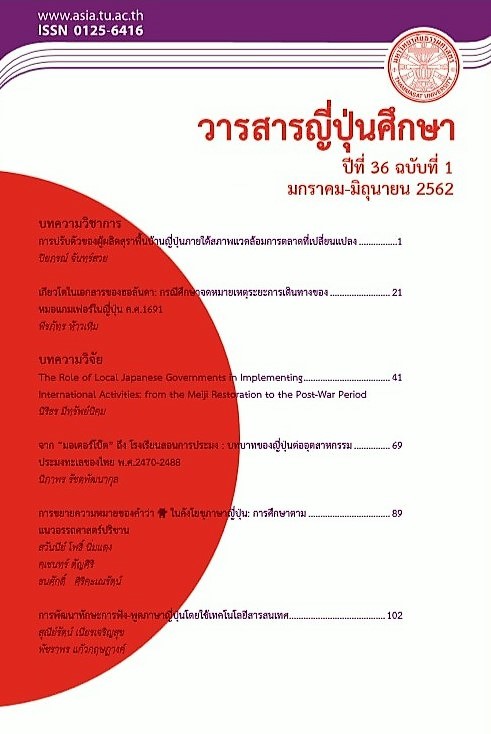From "Motor Boat" to "Fishing School": Japanese Roles in the Thai Fishing Industry, 1927-1945
Keywords:
Thai fishing industry, International technology transfer, Japan, OkinawaAbstract
The economic history of Thailand one decade prior to the outbreak of World War II has been frequently analyzed under the conceptual framework of Phibun-led nationalism policy, followed by the US- supported assistance during the Cold War in the late 1950s. This article focuses on the roles of Japan in Thailand's fishing industry during those two connected periods to reveal the base of technology transfer of Japan in Thailand before the World War II. Significantly, this technology transfer enabled Thailand to further and utilize the learned knowledge and practices under the mutual cooperation among Thailand, the US, and Okiwana which was ruled by US after the end of World War II.
Downloads
References
สจช. [1] มท 3.1.4.14/2 ผู้บังคับการเรือหลวงหาญทะเลจับชนชาติญี่ปุ่นรวม 19 คน ซึ่งเข้ามาทำการลักลอบจับสัตว์น้ำโดยไม่ได้รับอนุญาตในทะเลบริเวณเกาะลิบง อำเภอกันตัง (7 กุมภาพันธ์ 2477-26 กรกฎาคม 2478)
สจช. [1] มท 3.1.4.14/3 เรือตอปิโด 3 จับเรือยนต์ญี่ปุ่น 1 ลำชื่อ กวงอันกับเรือพ่วง 3 ลำ ซึ่งมาลักจับปลาที่เกาะกูด เกาะรัง อำเภอเกาะช้าง พวกญี่ปุ่นขัดขืนไม่ยอมขึ้นจากเรือ ศาลจังหวัดตราดอนุญาตให้โอนคดีมาชำระที่ศาลอาญาตามคำร้องขอของญี่ปุ่น (31 ตุลาคม -2 พฤศจิกายน 2478)
สจช. [1] มท 3.1.4.14/5 กรมเจ้าท่าหารือเรื่องการที่จะซ่อมแซมเรือของกลางที่ยึดไว้จากพวกญี่ปุ่นที่เข้ามาลักจับปลา (14 มกราคม-25 ธันวาคม 2478)
สจช. [1] มท 3.1.4.14/7 เรือยนต์ชาวญี่ปุ่นเข้ามาทำการลักลอบจับสัตว์น้ำ และชนเรือไทยล่มกลางทะเล (16 พฤศจิกายน-30 ธันวาคม 2479)
สจช. [1] มท 3.1.4.14/9 1.ชาวญี่ปุ่นร่วม 16 คน ใช้เรือยนต์ชื่อโตโชมารูเข้ามาลักลอบจับสัตว์น้ำที่เกาะพีพี 2.เรือสารสินธุ์ออกตรวจจับ 3.ส่งล่ามญี่ปุ่นไปในการดำเนินคดี (5 พฤศจิกายน 2480-23 เมษายน 2481)
สจช. [1] มท 3.1.4.14/11 เรือตระเวนวารียิงเรือหาปลาญี่ปุ่น (21-30 ธันวาคม 2480)
สจช. [3] สร.0201.31/6 นายมูยีคาวาขออนุญาตจับปลาโดยใช้เรือยนต์ (31 กรกฎาคม 2476)
สจช. [3] สร.0201.31/8 ปราบปรามและป้องกันชาวต่างประเทศลักลอบจับสัตว์น้ำในน่านน้ำสยาม (30 มีนาคม 2476-26 เมษายน 2477)
สจช. [3] สร 0201.31/9 เรื่องจัดตั้งบริษัทและขายปลาทะเล (บริษัทประมงไทย) 22 พฤษภาคม 2477-8 ธันวาคม 2495
สจช. [3] สร.0201.31/12 ห้ามไม่ให้ใช้เครื่องมือบางอย่างทำการจับสัตว์น้ำ (22 มกราคม 2477-21 สิงหาคม 2485)
สจช. [3] สร 0201.30/14 การตั้งเจ้าหน้าที่ทหารเรือเป็นโจทย์ในคดีลักลอบจับสัตว์น้ำ (2 มีนาคม 2477-31 ตุลาคม 2482)
สจช. [3] สร.0201.31/15 ญี่ปุ่นว่ารัฐบาลกวดขันเรื่องจับสัตว์น้ำทำให้ชาวประมงญี่ปุ่นเดือดร้อน (ชาวญี่ปุ่นลักจับปลา) (19 มิถุนายน-20 พฤศจิกายน 2478)
สจช. [3] สร.0201.31/17 เรื่องทะเลอาณาเขตร์จับสัตว์น้ำในน่านน้ำสยาม (4 มกราคม 2478-29 พฤษภาคม 2479)
เอกสารสำนักนายกรัฐมนตรี
รายงานการประชุมคณะรัฐมนตรี, ครั้งที่ 10/2478 (20 มกราคม พ.ศ. 2478).
รายงานการประชุมคณะรัฐมนตรี, ครั้งที่ 5/2479 (วันที่ 8 พฤษภาคม พ.ศ. 2479).
เอกสารภาษาไทย
กรมประมง. 2562. https://www.fisheries.go.th/sf-satun/images/download/17.pdf สืบค้นเมื่อ 2 มกราคม 2562
จุล วัจนะคุปต์. 2519. อนุสรณ์ในงานพระราชทานเพลิงศพ อำมาตย์โท นายจุล วัจนะคุปต์ (หลวงจุลชีพพิชชาธร) ท.ม., ท.ช. ณ เมรุวัดเทพศิรินทราวาส วันที่ 6 พฤศจิกายน พุทธศักราช 2519. กรุงเทพฯ: ชวนพิมพ์.
“ประกาศกระทรวงพระคลังมหาสมบัติ” ใน ราชกิจจานุเบกษา. เล่ม 50 (21 เมษายน 2476) , น.132.
“พระราชบัญญัติว่าด้วยสิทธิจับสัตว์น้ำในเขตต์จับสัตว์น้ำสยาม พุทธศักราช 2477,” ราชกิจจานุเบกษา เล่ม 51 (28 ตุลาคม 2477), น.795.
นิภาพร รัชตพัฒนากุล. 2545. ความสัมพันธ์ทางวัฒนธรรมระหว่างไทย-ญี่ปุ่น พ.ศ.2475-2488. วิทยานิพนธ์ศิลปศาสตรมหาบัณฑิต สาขาวิชาประวัติศาสตร์ มหาวิทยาลัยธรรมศาสตร์.
ธัญญารัตน์ สามัตถิยะ. 2545. ความสำคัญของปลาทูต่อสังคมและเศรษฐกิจไทย พ.ศ. 2397-2496. วิทยานิพนธ์ศิลปศาสตรมหาบัณฑิต สาขาวิชาประวัติศาสตร์ มหาวิทยาลัยธรรมศาสตร์.
หลวงมัศยจิตรการ. 2508. อนุสรณ์งานพระราชทานเพลิงศพหลวงมัศยจิตรการ (ประสพ ตีระนันทน์) ณ เมรุวัดเทพศิรินทราวาส 17 เมษายน 2508. พระนคร : โรงพิมพ์รุ่งเรืองรัตน์.
เอกสารภาษาอังกฤษและญี่ปุ่น
Butcher, John G. (2004). The Closing of the Frontier: A History of the Marine Fisheries of Southeast Asia c.1850-2000. Singapore: ISEAS Publication.
Gillett, Robert. (2007). A Short History of Industrial Fishing in the Pacific Islands. Bangkok: FAO Regional Office for Asia and the Pacific.
Hall, Stefan. (2011). The Role of European Technology, Expertise and Early Development Aid in the Modernization of Thailand before the Second World War. Journal of the Asia Pacific Economy 6(2): 158-178.
Katoka Chikashi. (1991). Nanyo no Nihon-jin Gyogyo. Tokyo: Dobunkan. (In Japanese)
Landon, Kenneth Perry. 1941. The Chinese in Thailand. New York: Russell and Russell.
Orishimo Sadao. (2014). Jakaruta Gyoko Monogatari: tomi ni arunda 40 nen. Tokyo: Saiki Insatsu. (In Japanese)
Shimizu, Hajime. The Pattern of Japanese Economic Penetration of Prewar Singapore and Malaya. In Shiraishi, S. and Shiraishi, T. (Ed), The Japanese in Colonial Southeast Asia. New York : Southeast Asia Program, Cornell University.
Shimizu, Hiroshi. (1997). The Japanese Fisheries Based in Singapore, 1892-1945. Journal of Southeast Asian Studies 28, 2 (September), 324-344.
Shiraishi, S. and Shiraishi, T. (Ed). 1993. The Japanese in colonial Southeast Asia. New York: Southeast Asia Program, Cornell University.
Swan, William L. (2009). Japan’s Economic Relations with Thailand: The Rise to ‘Top Trader’ 1875-1942. Bangkok: White Lotus.
Thompson, Virjinia. (1941). Thailand: The New Siam (New York: Macmillan). p.477
Yakage Yuko. (2011). Itoman niyoru Shingaporu kasegite gyomin-1920 nendai o chushin ni-. Machikaneyama ronso: Bunka doutai ron hen. 45, 15-35. (In Japanese)
Yamashita Haruko. (2012). Sakana no Keizai-gaku. Tokyo: Nihon Hyoron-sha.




